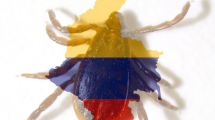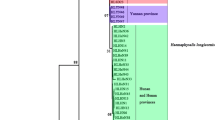Abstract
Hyalomma anatolicum, an Anatolian hard tick is a well-recognized vector involved in the transmission of various pathogens to animals and humans. The present study elucidated the population structure and haplotype network of H. anatolicum based on the mitochondrial large subunit ribosomal RNA (16S rRNA) gene sequence. The population structure and haplotype network analysis of 75 sequences archived in the GenBank, including the 15 sequences generated herein, yielded 24 haplotypes. Haplotype 1 (Hap_1) was the predominant haplotype consisting of 45 sequences from India, China, Pakistan, Turkey, Egypt, Iraq, and Tajikistan. The complete haplotype network exhibited a stellate conformation, highlighting a recent population expansion. The overall dataset, together with the sequences corresponding to India, China, and Pakistan, showed a high haplotype (0.638 ± 0.065, 0.671 ± 0.103, 0.753 ± 0.099, and 0.854 ± 0.061, respectively) and low nucleotide (0.00407 ± 0.00090, 0.00525 ± 0.00196, 0.00680 ± 0.00233, and 0.00453 ± 0.00056, respectively) diversity, further emphasized a recent population expansion. The neutrality indices including Tajima’s D, Fu and Li’s D, and Fu and Li’s F for the complete dataset (− 2.661, − 6.008, and − 5.649, respectively) as well as for the sequences from India (− 2.223, − 3.414, and − 3.567, respectively) were negative, suggesting deviation from neutrality and a recent population expansion. The present study provided novel insights into the population structure and haplotype networks of H. anatolicum based on the mitochondrial 16S rRNA gene, and the different tests inferred a low genetic differentiation and suggested a recent population expansion of this economically important tick species.



Similar content being viewed by others
Data availability
Data will be made available on request.
References
Agrios GN (2005) Genetics of plant disease. Plant pathology, 5th edn. Academic Press, Cambridge, Massachusetts, pp 124–174
Amzati GS, Pelle R, Muhigwa JB, Kanduma EG, Djikeng A, Madder M, Kirschvink N, Marcotty T (2018) Mitochondrial phylogeography and population structure of the cattle tick Rhipicephalus appendiculatus in the African Great Lakes region. Parasit Vectors 11(1):329. https://doi.org/10.1186/s13071-018-2904-7
Apanaskevich DA, Horak IG (2005) The genus Hyalomma Koch, 1844. II. The taxonomic status of H. (Euhyalomma) anatolicum Koch, 1844, H. (E.) excavatum Koch, 1844 (Acari: Ixodidae) with redescriptions of all stages. Acarina 13:181–197
Apanaskevich DA, Horak IG (2008) The genus Hyalomma Koch, 1844: V. Re-evaluation of the taxonomic rank of taxa comprising the H. (Euhyalomma) marginatum Koch complex of species (acari: Ixodidae) with redescription of all parasitic stages and notes on biology. Int J Acarol 34:13–42
Apanaskevich DA, Horak IG (2009) The genus Hyalomma Koch, 1844 IX. Redescription of all parasitic stages of H (Euhyalomma) impeltatum Schulze & Schlottke, 1930 and H (E) somalicum Tonelli Rondelli, 1935 (Acari: Ixodidae). Syst Parasitol 73(3):199–218. https://doi.org/10.1007/s11230-009-9190-x
Araya-Anchetta A, Busch JD, Scoles GA, Wagner DM (2015) Thirty years of tick population genetics: a comprehensive review. Infect Genet Evol 29:164–179. https://doi.org/10.1016/j.meegid.2014.11.008
Bakheit MA, Latif AA, Vatansever Z, Seitzer U, Ahmed J (2012) The huge risks due to Hyalomma ticks. In: Mehlhorn H (ed) Arthropods as vectors of emerging diseases, 1st edn. Springer-Verlag, Berlin, pp 167–194
Bandelt HJ, Forster P, Sykes BC, Richards MB (1995) Mitochondrial portraits of human populations using median networks. Genetics 141(2):743–753. https://doi.org/10.1093/genetics/141.2.743
Charlesworth B, Charlesworth D (2010) Elements of evolutionary genetics. Roberts & Company Publishers, Greenwood Village
Dantas-Torres F, Chomel BB, Otranto D (2012) Ticks and tick-borne diseases: an one health perspective. Trends Parasitol 28(10):437–446. https://doi.org/10.1016/j.pt.2012.07.003
Excoffier L, Lischer HE (2010) Arlequin suite ver 3.5: a new series of programs to perform population genetics analyses under Linux and windows. Mol Ecol Resour 10:564–567
Fu YX (1997) Statistical tests of neutrality of mutations against population growth, hitchhiking and background selection. Genetics 147(2):915–925. https://doi.org/10.1093/genetics/147.2.915
Guglielmone AA, Nava S (2014) Names for Ixodidae (Acari: Ixodoidea): valid, synonyms, Incertae sedis, Nomina dubia, Nomina nuda, Lapsus, incorrect and suppressed names—with notes on confusions and misidentifications. Zootaxa 3767:1–256
Gui Z, Wu L, Cai H, Mu L, Yu J-F, Fu S-Y, Si X-Y (2021) Genetic diversity analysis of Dermacentor nuttali within Inner Mongolia. China Parasit Vectors 14:131. https://doi.org/10.1186/s13071-021-04625-5
Hall TA (1999) BioEdit: a user-friendly biological sequence alignment editor and analysis program for Windows 95/98/NT. Nucleic Acids Symp Ser 41:95–98
Hasle G (2013) Transport of ixodid ticks and tick-borne pathogens by migratory birds. Front Cell Infect Microbiol 3:48. https://doi.org/10.3389/fcimb.2013.00048
Jonsson NN, Davis R, De Witt M (2001) An estimate of the economic effects of cattle tick (Boophilus microplus) infestation on Queensland dairy farms. Aust Vet J 79:826–831
Kumar B, Manjunathachar HV, Ghosh S (2020) A review on Hyalomma species infestations on human and animals and progress on management strategies. Heliyon 6(12):e05675. https://doi.org/10.1016/j.heliyon.2020.e05675
Leigh JW, Bryant D (2015) PopART: full-feature software for haplotype network construction. Methods Ecol Evol 6:1110–1116. https://doi.org/10.1111/2041-484210X.12410
Lew-Tabor AE, Rodriguez-Valle M (2016) A review of reverse vaccinology approaches for the development of vaccines against ticks and tick borne diseases. Ticks Tick Borne Dis 7:573–585
Moudgil AD, Nehra AK, Vohra S (2023a) Phylogeography and demographic dynamics of Rhipicephalus microplus from North India. Infect Genet Evol 112:105464. https://doi.org/10.1016/j.meegid.2023.105464
Moudgil AD, Daundkar PS, Nehra AK, Vohra S, Gupta S, Sharma D (2023b) Molecular characterization of Hyalomma dromedarii and evaluation of acaricidal potential of herbal methanolic extracts against H dromedarii larvae in comparison to synthetic acaricides. Exp Appl Acarol 89(1):141–156. https://doi.org/10.1007/s10493-022-00763-2
Nehra AK, Kumari A, Kundave VR, Vohra S, Ram H (2022) Molecular insights into the population structure and haplotype network of Theileria annulata based on the small subunit ribosomal RNA (18S rRNA) gene. Infect Genet Evol 99:105252. https://doi.org/10.1016/j.meegid.2022.105252
Páez-Triana L, Munoz M, Herrera G, Moreno-Perez DA, Tafur-Gomez GA, Montenegro D, Patarroyo MA, Paniz-Mondolfi A, Ramírez JD (2021) Genetic diversity and population structure of Rhipicephalus sanguineus sensu lato across different regions of Colombia. Parasit Vectors 14(1):424. https://doi.org/10.1186/s13071-021-04898-w
Perveen N, Muzaffar SB, Al-Deeb MA (2021) Prevalence, distribution, and molecular record of four hard ticks from livestock in the United Arab Emirates. Insects 12(11):1016. https://doi.org/10.3390/insects12111016
Roderick GK (1996) Geographic structure of insect populations: gene flow, phylogeography, and their uses. Annu Rev Entomol 41:325–352
Rollins RE, Schaper S, Kahlhofer C, Frangoulidis D, Strauss AFT, Cardinale M, Springer A, Strube C, Bakkes DK, Becker NS, Chitimia-Dobler L (2021) Ticks (Acari: Ixodidae) on birds migrating to the island of Ponza, Italy, and the tick-borne pathogens they carry. Ticks Tick Borne Dis 12:101590. https://doi.org/10.1016/j.ttbdis.2020.101590
Roth A, Akad F, Zonstein I, King R, Orshan L, Erster O (2019) Molecular characterization of six Hyalomma species using mitochondrial markers. Ticks Tick Borne Dis 10(4):911–917. https://doi.org/10.1016/j.ttbdis.2019.04.015
Rozas J, Ferrer-Mata A, Sanchez-DelBarrio JC, Guirao-Rico S, Librado P, Ramos- Onsins SE, Sanchez-Gracia A (2017) DnaSP 6: DNA sequence polymorphism analysis of large data sets. Mol Biol Evol 34:3299–3302. https://doi.org/10.1093/molbev/msx248
Sands AF, Apanaskevich DA, Matthee S, Horak IG, Harrison A, Karim S, Mohammad MK, Mumcuoglu KY, Rajakaruna RS, Santos-Silva MM, Matthee CA (2017) Effects of tectonics and large scale climatic changes on the evolutionary history of Hyalomma ticks. Mol Phylogenet Evol 114:153–165. https://doi.org/10.1016/j.ympev.2017.06.002
Senbill H, Tanaka T, Karawia D, Rahman S, Zeb J, Sparagano O, Baruah A (2022) Morphological identification and molecular characterization of economically important ticks (Acari: Ixodidae) from North and North-Western Egypt. Acta Trop 231:106438. https://doi.org/10.1016/j.actatropica.2022.106438
Tajima F (1989) Statistical method for testing the neutral mutation hypothesis by DNA polymorphism. Genetics 123(3):585–595. https://doi.org/10.1093/genetics/123.3.585
Tamura K, Nei M (1993) Estimation of the number of nucleotide substitutions in the control region of mitochondrial DNA in humans and chimpanzees. Mol Biol Evol 10:512–526
Tamura K, Stecher G, Kumar S (2021) MEGA 11: molecular evolutionary genetics analysis version 11. Mol Biol Evol 38(7):3022–3027. https://doi.org/10.1093/molbev/msab120
Tian Z, **e J, Yin H, Luo J, Zhang L, Zhang P, Luo J (2011) Discrimination between Haemaphysalis longicornis and H. qinghaiensis based on the partial 16S rDNA and the second internal transcribed spacer (ITS-2). Exp Appl Acarol 54:165–172. https://doi.org/10.1007/s10493-010-9423-3
Vatansever Z (2017) Hyalomma anatolicum. In: Estrada-Peña A, Mihalca AD, Petney TN (eds) Ticks of Europe and North Africa: a guide to species identification, 1st edn. Springer, Cham, pp 391–395
Vrijenhoek RC (1994) Genetic diversity and fitness in small populations. Conserv Genetics 1:37–53
Walker AR, Bouattour A, Camicas JL, Estrada-Pena A, Horak IG, Latif AA, Pegram RG, Preston PM (2003) Ticks of domestic animals in Africa: a guide to identification of species. The University of Edinburgh, Edinburgh
Yin F, Guo C, Tian Z, Li D, Mu D, Liu H, Guan G, Yin H, Li F (2023) Analysis of genetic diversity and population structure of Babesia gibsoni. Front Vet Sci 10:1147958. https://doi.org/10.3389/fvets.2023.1147958
Zeb J, Szekeres S, Takács N, Kontschán J, Shams S, Ayaz S, Hornok S (2019) Genetic diversity, piroplasms and trypanosomes in Rhipicephalus microplus and Hyalomma anatolicum collected from cattle in northern Pakistan. Exp Appl Acarol 79(2):233–243. https://doi.org/10.1007/s10493-019-00418-9
Zhang RL, Zhang B (2014) Prospects of using DNA barcoding for species identification and evaluation of the accuracy of sequence databases for ticks (Acari: Ixodida). Ticks Tick-Borne Dis 5:352–358. https://doi.org/10.1016/j.ttbdis.2014.01.001
Acknowledgements
The authors are thankful to the Director of Research and the Dean, College of Veterinary Sciences, Lala Lajpat Rai University of Veterinary and Animal Sciences for providing the necessary funds and facilities to carry out the research. Authors are also thankful to RKVY- RAFTAAR for enriching the department with the facilities which were utilized during the research.
Author information
Authors and Affiliations
Contributions
ADM was involved in conceptualization, sample collection, investigation, methodology, and writing. AKN was involved in sample collection, investigation, and laboratory work. NL and VK helped in the collection of samples. SV was involved in supervision and editing. All the authors contributed to the review.
Corresponding author
Ethics declarations
Ethics approval
The ticks were collected from the infested animal with the help of forceps with the permission of the Institutional Animal Ethics Committee (VCC/IAEC/2022/1679–1705) of Lala Lajpat Rai University of Veterinary and Animal Sciences, Hisar, Haryana, India.
Consent to participate
Not applicable.
Consent for publication
Not applicable as no human subjects/picture or videos were involved in the present study.
Competing interests
The authors declare no competing interests.
Additional information
Section Editor: Leonhard Schnittger.
Publisher's Note
Springer Nature remains neutral with regard to jurisdictional claims in published maps and institutional affiliations.
Supplementary Information
Below is the link to the electronic supplementary material.
Rights and permissions
Springer Nature or its licensor (e.g. a society or other partner) holds exclusive rights to this article under a publishing agreement with the author(s) or other rightsholder(s); author self-archiving of the accepted manuscript version of this article is solely governed by the terms of such publishing agreement and applicable law.
About this article
Cite this article
Moudgil, A.D., Nehra, A.K., Langyan, N. et al. Population structure and haplotype network analyses of Hyalomma anatolicum based on the large subunit ribosomal RNA (16S rRNA) gene. Parasitol Res 123, 259 (2024). https://doi.org/10.1007/s00436-024-08279-x
Received:
Accepted:
Published:
DOI: https://doi.org/10.1007/s00436-024-08279-x




